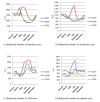Are there any changes in burden and management of communicable diseases in areas affected by Cyclone Nargis?
- PMID: 21708044
- PMCID: PMC3135519
- DOI: 10.1186/1752-1505-5-9
Are there any changes in burden and management of communicable diseases in areas affected by Cyclone Nargis?
Abstract
Background: This study aims to assess the situation of communicable diseases under national surveillance in the Cyclone Nargis-affected areas in Myanmar (Burma) before and after the incident.
Methods: Monthly data during 2007, 2008 and 2009 from the routine reporting system for disease surveillance of the Myanmar Ministry of Health (MMOH) were reviewed and compared with weekly reporting from the Early Warning and Rapid Response (EWAR) system. Data from some UN agencies, NGOs and Tri-Partite Core Group (TCG) periodic reviews were also extracted for comparisons with indicators from Sphere and the Inter-Agency Standing Committee.
Results: Compared to 2007 and 2009, large and atypical increases in diarrheal disease and especially dysentery cases occurred in 2008 following Cyclone Nargis. A seasonal increase in ARI reached levels higher than usual in the months of 2008 post-Nargis. The number of malaria cases post-Nargis also increased, but it was less clear if this reflected normal seasonal patterns or was specifically associated with the disaster event. There was no significant change in the occurrence of other communicable diseases in Nargis-affected areas. Except for a small decrease in mortality for diarrheal diseases and ARI in 2008 in Nargis-affected areas, population-based mortality rates for all other communicable diseases showed no significant change in 2008 in these areas, compared to 2007 and 2009. Tuberculosis control programs reached their targets of 70% case detection and 85% treatment success rates in 2007 and 2008. Vaccination coverage rates for DPT 3rd dose and measles remained at high though measles coverage still did not reach the Sphere target of 95% even by 2009. Sanitary latrine coverage in the Nargis-affected area dropped sharply to 50% in the months of 2008 following the incident but then rose to 72% in 2009.
Conclusion: While the incidence of diarrhea, dysentery and ARI increased post-Nargis in areas affected by the incident, the incidence rate for other diseases and mortality rates did not increase, and normal disease patterns resumed by 2009. This suggests that health services as well as prevention and control measures provided to the Nargis-affected population mitigated what could have been a far more severe health impact.
Figures
Similar articles
-
Community-based assessment of human rights in a complex humanitarian emergency: the Emergency Assistance Teams-Burma and Cyclone Nargis.Confl Health. 2010 Apr 19;4:8. doi: 10.1186/1752-1505-4-8. Confl Health. 2010. PMID: 20403200 Free PMC article.
-
Community awareness and perceptions of health sector preparedness and response to Cyclone Nargis.Southeast Asian J Trop Med Public Health. 2011 Jul;42(4):1014-21. Southeast Asian J Trop Med Public Health. 2011. PMID: 22299485
-
Evidence of health system resilience in Myanmar during Cyclone Nargis: a qualitative analysis.BMJ Open. 2021 Sep 22;11(9):e050700. doi: 10.1136/bmjopen-2021-050700. BMJ Open. 2021. PMID: 34551949 Free PMC article.
-
Analyzing the impact of severe tropical cyclone Yasi on public health infrastructure and the management of noncommunicable diseases.Prehosp Disaster Med. 2015 Feb;30(1):28-37. doi: 10.1017/S1049023X1400137X. Epub 2014 Dec 29. Prehosp Disaster Med. 2015. PMID: 25544290 Review.
-
Measles, mumps, rubella prevention: how can we do better?Expert Rev Vaccines. 2021 Jul;20(7):811-826. doi: 10.1080/14760584.2021.1927722. Epub 2021 Jun 7. Expert Rev Vaccines. 2021. PMID: 34096442 Review.
Cited by
-
Health impacts of climate change on smallholder farmers.One Health. 2021 Apr 29;13:100258. doi: 10.1016/j.onehlt.2021.100258. eCollection 2021 Dec. One Health. 2021. PMID: 34027006 Free PMC article. Review.
-
Mekong Basin Disease Surveillance (MBDS): a trust-based network.Emerg Health Threats J. 2013;6. doi: 10.3402/ehtj.v6i0.19944. Epub 2013 Jan 25. Emerg Health Threats J. 2013. PMID: 23362411 Free PMC article.
-
Incidence of Typhoid and Paratyphoid Fevers Among Adolescents and Adults in Yangon, Myanmar.Clin Infect Dis. 2019 Mar 7;68(Suppl 2):S124-S129. doi: 10.1093/cid/ciy1109. Clin Infect Dis. 2019. PMID: 30845332 Free PMC article.
-
Impacts of different grades of tropical cyclones on infectious diarrhea in Guangdong, 2005-2011.PLoS One. 2015 Jun 24;10(6):e0131423. doi: 10.1371/journal.pone.0131423. eCollection 2015. PLoS One. 2015. PMID: 26106882 Free PMC article.
-
The Great East Japan Earthquake: a need to plan for post-disaster surveillance in developed countries.Western Pac Surveill Response J. 2011 Dec 23;2(4):3-6. doi: 10.5365/WPSAR.2011.2.4.007. Print 2011 Oct. Western Pac Surveill Response J. 2011. PMID: 23908893 Free PMC article.
References
-
- Coppola DP. Introduction to international disaster management. Elsevier; 2007.
-
- Cater WN. Disaster management: A disaster manager's handbook: ADB. 1991.
-
- Checchi F, Gayer M, Grais RF, Mills EJ. Public health in crisis-affected populations: A practical guide for decision-makers: the Humanitarian Practice Network. 2007.
-
- World Health Organization. Technical guidelines for health action in crises WHO. 2009. http://www.who.int/hac/techguidance/en/ [updated 2009; cited 4.7.2009]
LinkOut - more resources
Full Text Sources




